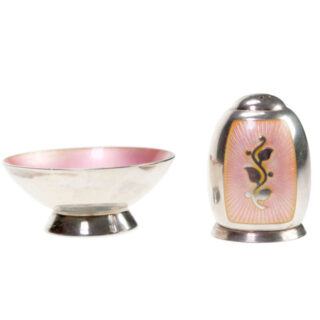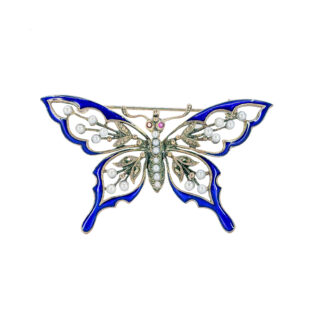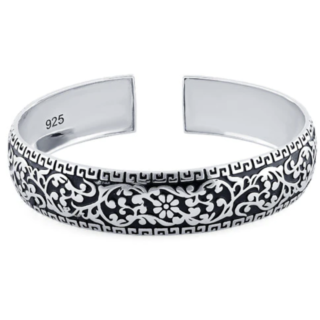This gorgeous cup is decorated with champlevé enamel and is crafted in silver. It was made by D. Anderson in Norway around 1925. Champlevé is a decorative technique in which small cells or compartments are carved into a metal surface and then filled with enamel or other materials to create a colorful design.
Details: Enamel, Silver Cup *.
Dimensions: H 6.5 x W 6 cm .
Weight in grams: 87.
Condition: Very good condition – slightly used with small signs of wear.
Shipping and Pickup: This gorgeous piece ships from our store located in the center of Amsterdam, The Netherlands. We offer both registered shipping and local pickup at our store. In the case of local pickup, any applicable shipping costs will be refunded.
About Us: Add some sparkle to your style with Binenbaum.com. We offer a stunning selection of antique and vintage jewelry that you won’t find anywhere else. From timeless rings and dazzling necklaces to unique brooches, we have something for every taste and occasion. Visit our website today and treat yourself to a piece of history.
| Design Era | |
|---|---|
| Design & Historical Context | Art Deco jewelry, also known as Jazz Age jewelry, became popular in the 1920s and remained in style through the 1930s. It was named after the Exposition International des Arts Décoratifs et Industriels Modernes, a exhibition held in Paris in 1925 that was largely dedicated to the jewelry arts. This style was inspired by a variety of cultural and artistic movements, such as Oriental, African, and South American art, as well as Cubism and Fauvism. Art Deco jewelry is known for its sharp, straight lines and emphasis on modernity and the machine age. During the Art Deco era, there were significant improvements in diamond cutting techniques, which made diamonds more radiant and sparkling than ever before. This, along with increased prosperity, allowed more people to afford diamond jewelry and engagement rings. Additionally, new casting techniques made it possible to produce more intricate and detailed settings. Art Deco jewelry was not only fashionable but also reflected the social and cultural changes of the time. The bold, modern design of Art Deco jewelry reflected the liberation and empowerment of women during the 1920s and 1930s. Today, Art Deco jewelry is highly sought after by collectors and is often featured in museum exhibitions and high-end auctions. |
| Key Materials | |
| Materials & Craftsmanship | Silver: The Metal of Elegance and Versatility Silver, known for its bright, reflective luster, is one of the most beloved and widely used precious metals in the world. This versatile metal has been cherished for thousands of years, not only for its beauty but also for its malleability, making it ideal for crafting intricate and delicate jewelry designs. Historically, silver has been associated with the moon and considered a symbol of purity, clarity, and protection. Ancient civilizations, from the Egyptians to the Greeks and Romans, valued silver for its beauty and used it to create coins, jewelry, and religious artifacts. In many cultures, silver is also believed to have healing properties, often used in amulets and talismans to ward off negative energy. In modern jewelry, silver is prized for its affordability, versatility, and timeless appeal. Sterling silver, an alloy of 92.5% pure silver and 7.5% other metals (usually copper), is the standard used in high-quality jewelry. Its durability and bright, reflective surface make it an excellent choice for a wide range of designs, from minimalist pieces to ornate creations. Silver can be polished to a high shine or given a matte, oxidized, or antiqued finish to suit various styles. Silver is more than just a metal; it is a symbol of elegance, flexibility, and understated luxury. Its enduring popularity and wide-ranging applications make it a staple in jewelry that can complement any look, from casual to formal, with timeless grace. Enamel: The Artful Fusion of Color and Craftsmanship Enamel is a decorative technique that has been used in jewelry for centuries, known for its ability to bring vibrant color and intricate designs to metal surfaces. Created by fusing powdered glass to metal at high temperatures, enamel can produce a wide range of colors, from bold and opaque to translucent and delicate. Historically, enamel has been used across various cultures, from ancient Egypt and China to Renaissance Europe, to create stunning works of art in jewelry, religious artifacts, and decorative objects. The intricate process of enameling, which requires skill and precision, has made it a prized technique among artisans. In contemporary jewelry, enamel is appreciated for its versatility and ability to enhance the beauty of metalwork. It can be used to add a pop of color to a piece, create detailed imagery, or produce a smooth, glossy finish that complements gemstones and precious metals. Enamel not only adds a burst of color and creativity to jewelry but also represents the craftsmanship and artistry behind each piece. Whether in modern or vintage designs, enamel brings a unique and timeless appeal to jewelry, making it a cherished choice for those who appreciate fine detail and vibrant hues. |
| Dimensions | H 6.5 x W 6 cm |
| Gender | |
| Weight (in grams) | 87 |
| Condition | Very good condition – slightly used with small signs of wear |
Enhance the Beauty of Your Jewelry with Proper Care
Wearing your jewelry is a special way to express yourself and add a touch of personal style to any look. However, to ensure your jewelry remains in pristine condition, there are a few simple steps you need to take to keep it looking its best.
General Care Instructions:
Remove jewelry when showering or bathing, especially when at the beach, in the sea or in chlorinated water.
Avoid wearing jewelry while doing physical work such as housekeeping, gardening or exercise.
Storing your jewelry in a dry and cool place will help protect it from moisture, dirt and dust.
Keeping it away from harsh chemicals such as bleach, ammonia and chlorine will help to avoid discoloration and damage.
Cleaning your jewelry regularly with a soft cloth will help to keep it looking shiny and new.
Avoid exposing your jewelry to extreme temperatures, such as leaving it in direct sunlight or near a heater, as this can cause damage.
Handle your jewelry carefully and avoid dropping it, as this can cause the stones to loosen or the metals to scratch.
Finally, if possible, have your jewelry professionally checked and serviced. This will ensure that any potential problems are spotted and fixed before they become worse.
By following these tips, you can enjoy your precious jewelry for many years to come.
Related Products
-
Enamel Marcasite (Pyrite) Pearl Silver Champlevé Pendant 13472-1270
€ 295,00 VAT incl. (where applicable) -
Enamel Silver Salt Cellar And Condiment Bowl Condiments 3451-2023
€ 495,00 VAT incl. (where applicable) -
Enamel Pearl Ruby Silver Butterfly Brooch 16216-2504
€ 225,00 VAT incl. (where applicable) -
Enamel Silver “Doctor” Figurine 15714-3119
€ 1.695,00 VAT incl. (where applicable) -
1900 French Silver Cup Elegance 12043-2874
€ 695,00 VAT incl. (where applicable) -
Enamel Silver Engine Turned Napkin Ring 8181-2569
€ 185,00 VAT incl. (where applicable) -
Enamel Silver Cuff Bracelet 14768-1846
€ 265,00 VAT incl. (where applicable) -
Enamel Silver Silver-Gilt Guilloche Box 1427-1904
€ 795,00 VAT incl. (where applicable)
- Home
- Collection
- Fine Jewelry
- Silver Jewelry
- Silverware
- Boxes
- Candlesticks
- Salt and pepper shakers
- Miniatures
- Salt cellars
- Spoon Set
- Condiments
- Frames
- Napkin Ring
- Spoon
- Oddities
- Cups
- Vases
- Cutlery
- Serving Spoon And Cake Server
- Candlesticks
- Baskets
- Hanukkiah
- Spice Tower
- Yad
- Tea Set
- Sugar Castor
- Napkin Rings
- Wine Bottle Coaster
- Wine Stopper
- Tea Pot
- Jugs
- Rattles
- Hip Flask
- Miscellaneous
- Rings 💍
- About
- Contact















